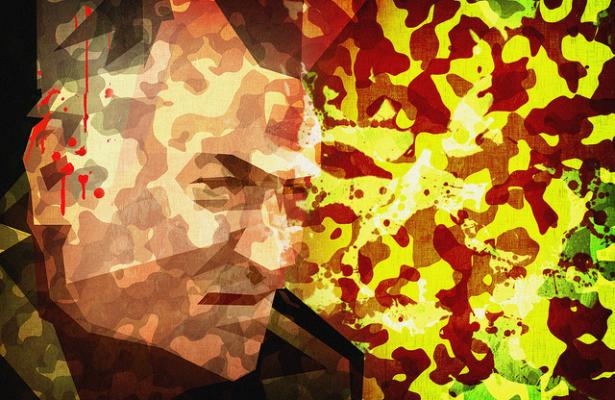Tom Kenis heeft een achtergrond in Islamstudies en Internationale Betrekkingen. Hij woonde en werkte vier jaar in het Midden-Oosten en in Berlijn.
Mladic versus Bin Laden method
The US operation in May 2011 that killed 9/11 mastermind Osama Bin Laden couldn’t have contrasted more with the low-key arrest a few weeks later of Ratko Mladic, a man held responsible by the International Criminal Tribunal for the former Yugoslavia for the siege of Sarajevo, and the Srebrenica massacre, the largest mass-murder in Europe since World War II, during the Bosnian civil war from 1992-1995.
With a 25 million dollar bounty on his head Osama Bin Laden for nearly ten years lived under constant fear, one presumes, of getting blown to bits by American drone aircraft or, as it would pan out, shot in the head by a crack team of U.S. navy SEALs rappelling down helicopters in the dead of night.
Ratko Mladic, and others wanted by the The Hague, a mere 5 million dollars offered for his arrest, became the object of endless rounds of diplomatic wrangling, economics sanctions and postponed EU aspirations for Serbia, widely suspected of harboring him. Pakistan in turn continued to receive American military aid –some 18 billion between 2001 and 2011- throughout Bin Laden’s semi-comfortable residency there, four blocks away from a large military academy and a mere two hours drive from Islamabad.
A comparison between the way both men were brought to justice / crudely dispatched should of course be qualified by an appreciation of the differences or similarities between their respective crimes. The backdrop of Ratko Mladic’s campaign of atrocities in the Bosnian hills was a civil war raging in the European Union’s backyard, as opposed to Bin Laden’s brazen attack against U.S sovereign soil. It is doubtful the EU’s methods would have been equally measured in case of a spectacular attack on a EU capital.
While U.S. interest in preventing a repetition of 9/11 was clear and direct, international and more specifically E.U. attempts at stopping, and afterwards, preventing bloodshed in the former Yugoslavia were steeped in the desire for a stable hinterland, possible expansion as well as a delicate sense of shame, of not being able to prevent crimes reminiscent of those committed by Nazi Germany and its allies.
Europe’s softly-softly approach to catch Mladic runs eerily parallel to its ineffectual actions to stop the massacres as they were taking place. Dutch UN soldiers, poorly armed and without a clear mandate, more or less stood by, watching; or rather, fishtailing away from the scene in order not to see. While it’s worth remembering American muscle finally put a stop to the Bosnian civil war, initial foot-dragging in the arrest and prosecution of war criminals was in part due to American and other NATO partners’ reluctance to upset a brittle post-war peace process.
The lackluster pursuit of Bosnian war criminals becomes even more striking when one compares, uncouthly, the scope of the crimes and, more perversely, the number of victims. While Bin Laden’s attacks claimed about 3.000 lives, the siege of Sarajevo and massacre of Screbrenica alone took 18.000. Figures for the entire civil war range up to 40.000 civilians (not to mention about 57.000 soldiers) on all sides.
Perhaps then, the cases are probably too different to speak of a European versus a typically American approach. It arguably makes more sense to speak of a Mladic versus Bin Laden method. Both cases offer lessons to be learned in the nebulous realm of prosecuting war crimes, terror attacks, or more generally: anything ill-suited for national courts to deal with. Might Bin Laden have been apprehended in Pakistan using a mix of sit-and-wait, sticks-and-carrots? Might a couple of years worth of sanctions on the Afghan Taliban regime have done the trick? Would Europe be safer practicing extra-judicial killings, filling an un-closable detention camp on, say, Malta, with all kinds of baddies ranging from Irish splinter groups to Red Brigade terrorists to wayward Muslim pulpit bullies?
A realistic inclination lowers one’s expectations that a swift change can take place from international cowboy justice to a more regulated approach. Or worse still, whether Europe is able to hold on to common sense under pressure of its own brand of anti-jihadist firebrands. However, with Mladic and other’s transfer to The Hague an important precedent has been set. Impunity is on the way out. More importantly, it’s now been abundantly demonstrated that in order to implement justice, it isn’t necessary to place oneself outside the bounds of the law.
Maak MO* mee mogelijk.
Word proMO* net als 2798 andere lezers en maak MO* mee mogelijk. Zo blijven al onze verhalen gratis online beschikbaar voor iédereen.
Meer verhalen
-
Report
-
Report
-
Report
-
Interview
-
Analysis
-
Report











 Oxfam België
Oxfam België Handicap International
Handicap International